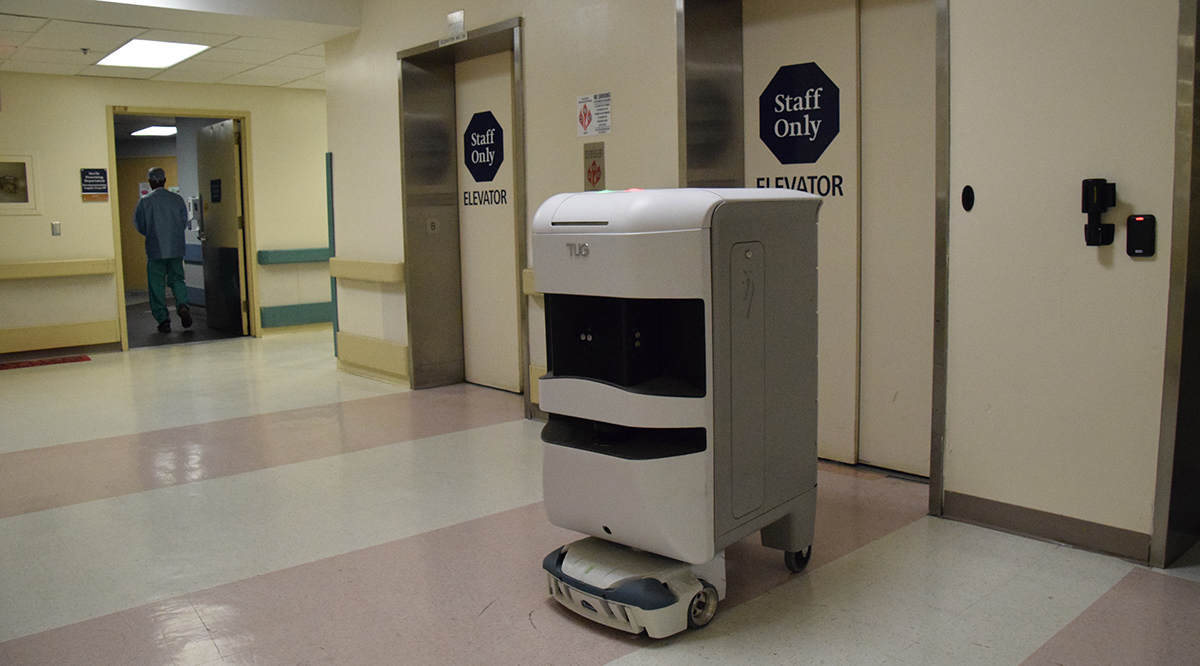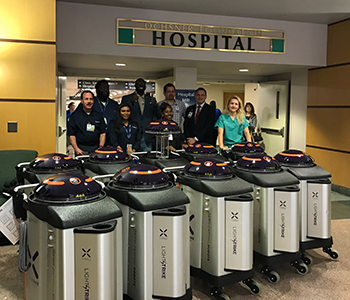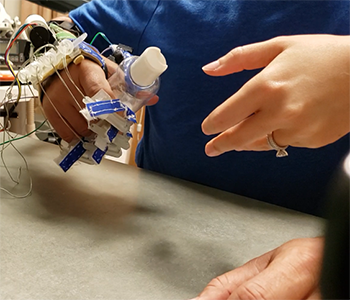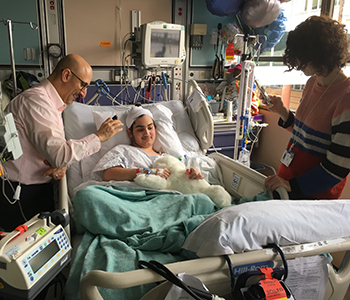
R2-D2. The Jetson’s Rosie. WALL-E, Baymax from Big Hero 6, and the Transformers — all these live only in various imaginary worlds. But stepping — or rolling — out of science fiction and into hospitals each day are thousands of real robots capable of performing varied bits of high-tech magic.
Setting aside surgical robots — a growing and sometimes hotly debated field — robots in hospitals tackle a broad range of tasks. They help guide rehabilitation exercises, shoot UV rays to disinfect rooms, and chug along hallways delivering everything from linens to lunches. Sometimes, they even offer patients much-needed emotional support.
“There’s a whole variety of things robots can do,” says Anil Kishore, MS, associate director of pharmacy at MedStar Washington Hospital Center, where robots deliver nearly 80,000 medications to care providers each year. “The goal is the harnessing of technology for safe patient care. We want to free up humans to do more substantial tasks. This is about figuring out how to use technology to your best advantage.”
Indeed, when it comes to certain jobs, robots are faster, stronger, cheaper, and less prone to error than their human counterparts, say experts. And they can plod along with an unparalleled single-mindedness.
“We want to free up humans to do more substantial tasks. This is about figuring out how to use technology to your best advantage.”
Anil Kishore, MS
MedStar Washington Hospital Center
Of course, robots are not appropriate for every assignment since they lack the human touch and, at times, need extensive supervision. They’re also not necessarily the right fit for every institution. For example, experts note that they’re more likely to appear in academic medical centers, which tend to have the scale, budget, and types of cases that make the investment worthwhile.
Still, the hundreds of U.S. hospitals that currently employ robots are part of a fast-growing market. By 2025, global medical robot expenditures will increase by approximately 20% to $24.6 billion, spurred in part by technological advances, according to the research firm Zion Global Research.
What’s more, patients tend to appreciate robotic assistance. “Generally, feedback has been very favorable,” says Joel Stein, MD, chair of rehabilitation and regenerative medicine at Columbia University Medical School. “They like the novelty,” he notes. “They like the ‘gee whiz’ aspect of integrating technology into care.”
A robot walks into an elevator …
The daily to-do list of Luke, a delivery robot at MedStar Washington, is pretty packed. First, get loaded with hundreds of medications. Then, chug along to programmed destinations using dozens of sensors to avoid walls. At the same time, shoot out an electronic signal to the elevator’s controller system to request a ride. When faced with obstacles, politely utter, "Please step aside." Upon arrival, send a message for someone to come unload the delivery. Get unloaded. Return. Repeat — and repeat and repeat.
Luke is one of hundreds of TUG delivery robots that deliver food, medical specimens, and more at over 150 hospitals in the United States and elsewhere, according to its manufacturer, Aethon.
“Robots made sense for us because of our size and complexity,” says Kishore. In fact, in the first half of 2019 alone, MedStar Washington’s six TUGs traveled 1,554 miles and made 13,800 stops, delivering medications, linens, and other essentials.
At MedStar Washington, pharmacy staff prepare the medications, but at other hospitals robots assist with that job as well. At University of California, San Francisco (UCSF), for example, robots process medication orders for three of its hospitals. Using mechanical arms, they select and sort medications into barcoded packets for individual patients.
Across the country from UCSF, a robotic delivery system shuttles meals to patients at Boston Children’s Hospital. There, six machines drop off roughly 2 million meals each year. And at Children’s, the machines come decked out as toy trains to deliver smiles along with the food.
Medstar Washington’s delivery robots wear costumes only a few times a year — one got a Minions makeover for Halloween, for example — but they offer lots of high-tech features. Mary Jane Turner, a pharmacy applications specialist, particularly appreciates their “MedEx” component, which enables staff to track the robots’ location.
“This is technology that’s already being used every day in other areas of our lives,” she says. “This is just bringing it into the hospital. People know when their packages are going to arrive at home, so why shouldn’t we know where our medications are at all times?”
Zapping pathogens
Approximately 1 in 31 hospital patients in the United States has a health care-associated infection (HAI) on any given day. Standard disinfection techniques from the Centers for Disease Control and Prevention help reduce pathogens, but high-intensity UV light can do even more, research suggests.
That’s where robots like Henry Ford Hospital’s Germinator and Zappy come in. They’re part of a growing group of approximately 800 hospitals nationwide that use some sort of disinfecting robots, according to Xenex, a robot manufacturer.
“Some people thought they robots would replace staff. But we actually had to hire more employees to run the robots.”
Jennifer Ritz, RN
Henry Ford Hospital
Henry Ford Director of Environmental Services Jennifer Ritz, RN, says she appreciates the robots’ simplicity. “The robot is easy to program. Once it’s placed in the room and started, the head pops up and turns around while the UV rays are pulsating throughout the room. [Then] staff go back in to flip the mattress and reposition the robot to ensure the entire room receives the UV rays.”
The transition wasn’t completely smooth, though. “Some people thought the robots would replace staff,” she says. “But we actually had to hire more employees to run the robots.” Safety concerns have evaporated too, she says, in part because a sensor placed outside the room shuts the robot down if someone starts to enter.
To ensure an effective transition at Ochsner Health System, leaders there onboarded disinfecting robots gradually over the past two years, starting with the flagship Ochsner Medical Center.

“In a community hospital, we may have just one,” says Sandra Kemmerly, MD, medical director for hospital quality. “In our flagship [location], where we have 17, it’s our intent to treat every single room when a patient is discharged or transferred to another room. It makes sense to do that there because we have more complex patients, like transplants and orthopedic surgery.”
One of Kemmerly’s favorite features is the robots’ ability to collect vital data, such as which rooms they’ve treated and for how long. Kemmerly also appreciates that the Xenex robots provide a very broad range of UV light in a short time, roughly 15 minutes per room.
But Kemmerly and Ritz caution that robots are just one part of keeping hospitals clean. “Robots just augment our normal process,” says Ritz. “We know we also need to focus on handwashing and other best practices if we are going to prevent HAIs.”
Robotic rehabilitation
When Dotty Attie suffered a stroke that affected her ability to use her hand, she went to a Columbia University Medical Center clinic for a research study that featured a rehabilitative robot.
There, the technician strapped her hand into a robotic device made of motors, wires, Velcro, and hard plastic pieces. Then Attie opened and closed her hand, shooting data to the robot so it could calculate the extent of her abilities and, when necessary, finish the motions for her. “I would start to open my hand and all of a sudden it would open completely,” she explains. “With the robot, I was opening and closing my hand so much that my brain was getting retrained. It was amazing.”
Robots like the one Attie used have helped build flexibility, strength, and range of motion among patients with conditions such as brain injury, paralysis, and multiple sclerosis. But do they do it better than humans?

One upside to robots is their systematic nature, which helps ensure accuracy and consistency. But most robots still require lots of human supervision, Stein adds. And he doesn’t foresee robots ever snatching huge numbers of humans’ jobs. “It’s very important in rehabilitation to have someone cheering you on, someone to motivate and to support you.”
Gerard Francisco, MD, chair of physical medicine and rehabilitation at McGovern Medical School at the University of Texas Health Science Center at Houston, emphasizes another positive that robots offer. “A smart robot can collect and perhaps even analyze data,” he says. “That’s great when insurers are looking for objective quantification of patient improvement.”
Looking ahead, Francisco hopes medical schools will teach more about robots and other high-tech tools. “Students need more exposure to novel technologies,” he says. “If they’re going to improve patient outcomes, most will need to know how to use these advances.”
Snuggly robots
Among the skills of Paro the robotic baby seal is batting its long eyelashes, emitting soft coos, and turning its soft white head. Paro, which has soothed patients at dozens of hospitals, offers many plusses of pet therapy with fewer drawbacks, users say. “Unfortunately, we are not able to have pet therapy in the PICU for most patients, and Paro provides some level of interaction and support,” explains Vivienne Newman, pediatric intensive care unit (PICU) clinical director at UCSF Children’s Hospital.

Here’s how Paro works: Its embedded sensors respond to touch, light, sound, and other stimuli. It can turn its head toward a voice, for example. And the more a patient uses it, the more it adapts its behavior accordingly. So, if flapping its tail gets it stroked, it will flap more frequently.
Patients seem receptive. One recent study found that dementia patients were less anxious and used less pain medication when they regularly interacted with Paro. Sandra Petersen, a University of Texas at Tyler researcher who collaborates with Baylor Scott and White Medical Center – Irving, where Paro visits hundreds of patients each month, says she’s seen the effects firsthand.
“I remember one patient with dementia who missed her four cats back home. It was absolutely amazing to see her reaction to Paro,” says Petersen. “We could see her anxiety and agitation drop. I wasn’t a believer at first, but I turned into a believer after that.”
Another fluffy robot attracting believers is Huggable, the robotic bear. “We’re really struck by how children perceive this bear as an independent creature,” says Deirdre Logan, PhD, director of psychological services at Boston Children’s Hospital’s division of pain medicine. “Most really seem to open up and connect with him.”
Logan is a co-author of the first-ever study showing that “social robots” boost positive emotions in hospitalized children. When compared with a stuffed animal and a digitized version of Huggable, the robot scored significantly better on such measures as patients’ level of engagement and positive facial expressions.
For now, Huggable is operated remotely by humans hiding in the hall — they can hold full conversations in a childlike voice, for example — but the hope is that it might one day work autonomously. One possibility is that a child could wear a sensor that would alert Huggable to signs of anxiety. “In response, it might deliver a coping intervention like distraction or a relaxation technique — just like a human would,” explains Logan.
A future for robots?
Much potential lies ahead for mechanical staff members, experts say.
One type of robot is learning to help patients put on hospital gowns, for example, while a Japanese company built a robot that can lift and carry patients. Robots also have been performing CPR, and researchers are exploring their effectiveness. And humanlike machines may welcome patients when they arrive for appointments.
“One area that’s still in development but very interesting is robots that [directly] assist patients. It might get your slippers for you or just keep you company,” says Stein.
But Sherry Turkle, PhD, an expert on humans’ relationship with technology, advises caution. “Simulated thinking may be thinking, [but] simulated feeling is not feeling,” says the Massachusetts Institute of Technology professor. “We diminish our human uniqueness when we pretend that machines can do what only human beings know how to do.”
Still, the pull toward creatures with computer code pulsing through their “veins” may be irresistible. Take Ritz’s response to the germ-blasting machines at her hospital. “I love these robots,” she says. “I so appreciate what they do for patient safety. It’s great to have them on our team.”
